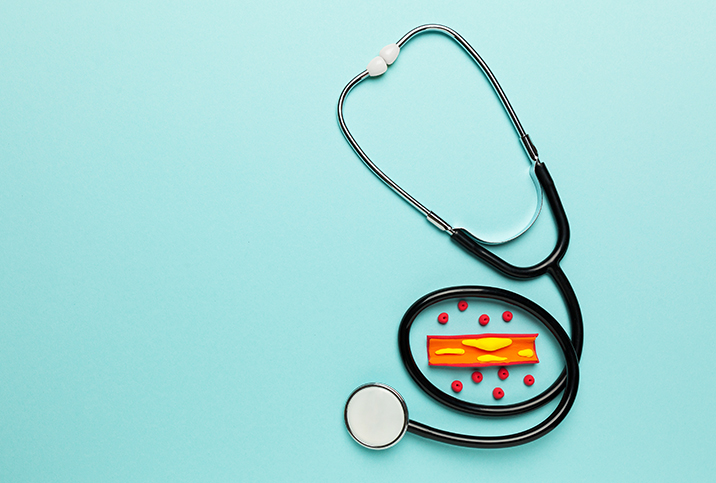How Reversible Is Coronary Artery Disease?

The way clogged arteries were typically explained in the 1990s was that as you get older, fatty residue from the food you eat collects and builds up on the inside of your artery walls as plaque. This action was an inevitable ramification of getting older, presented as somewhat avoidable but a logical, natural consequence of American life and dining habits.
Obviously, we've learned a lot about diet, exercise and cardiovascular health over the past few decades, because it's now evident the onset and development of coronary artery disease (CAD) is highly avoidable. But is CAD also reversible?
CAD and its seriousness
Once CAD reaches clinical levels of buildup, options become limited for reversing damage, according to Eugene Yang, M.D., chair of the Prevention of Cardiovascular Disease Council for the American College of Cardiology, based in Washington, D.C.
"That has been the holy grail of cardiovascular medicine, trying to figure out, 'Is there a way that once cholesterol buildup occurs in your arteries that leads to a higher risk of heart attack and stroke, can you somehow reverse that process?'" he said. "The reality is that's not something that has been demonstrated in many different studies with different types of medications or interventions."
Once calcium buildup in the arteries is severe enough the patient is at risk of heart attack or stroke, the process can't be reversed, and doctors are likely to resort to a variety of medications to treat the body-wide consequences of coronary artery disease. Medicines such as statins and niacin may be used to lower cholesterol levels. Doctors may also focus on lowering blood pressure with beta blockers, angiotensin-converting enzyme (ACE) inhibitors or other medications, depending on the circumstances of the patient.
Since the 'holy grail of cardiovascular medicine' still eludes the medical community, doctors instead focus on the prevention of CAD development.
It's also common for people living with coronary artery disease to be on aspirin or other anticoagulants as well as nitrates and medications to prevent angina.
Since the "holy grail of cardiovascular medicine" still eludes the medical community, doctors instead focus on the prevention of CAD development, which includes trying to stabilize any cholesterol buildup in the arteries, so people are less likely to suffer a heart attack or stroke.
That sounds great, but doctors and patients need tools to accomplish the goal. Obviously, exercise and healthy living are familiar calling cards of countering CAD development, but in the past decade, new data concerning familiar technologies has become increasingly important.
Forming a picture of CAD
Imaging studies have become an indispensable tool in the detection of CAD.
"There's something called a coronary calcium score, which is a test where you basically image the heart arteries by doing sort of a more complicated X-ray or a CAT scan, and you can see calcification or calcium buildup within the lining of the arteries of your heart," Yang said. "We know that calcium is a marker of subclinical coronary artery disease, so having the presence of calcification that's visualized in your arteries is sort of a window into your heart and can allow us to see whether cholesterol buildup is already present or not."
Detecting CAD at this stage of subclinical development could be loosely compared to identifying somebody as prediabetic. The condition hasn't worsened to the point of requiring immediate intervention or necessarily threatening the patient with a significantly elevated risk of issues like cardiac events, but the person's arterial buildup is severe enough that preventive intervention is recommended. Effective methods could entail a change in lifestyle practices—think nutrition, exercise or the elimination of bad habits such as smoking.
Men dealing with erectile dysfunction may find solutions in the same images that can predict a person's likelihood of suffering a stroke or heart attack.
For men, understanding and visualizing what's occurring in the coronary arteries can be revealing in relation to problems with sexual function, because abnormalities in blood flow are a common cause of erectile dysfunction (ED), said Ron Blankstein, M.D., a cardiologist and professor of medicine at Harvard Medical School and the associate director of the cardiovascular imaging program at Brigham and Women's Hospital in Boston.
Men dealing with erectile dysfunction may find solutions in the same images that can predict a person's likelihood of suffering a stroke or heart attack, added Blankstein, who specializes in cardiovascular imaging.
"Potentially, men that have erectile dysfunction, if they may not know that they have heart disease, these are men that maybe need to be evaluated a little more carefully," he said, adding that imaging of a person's arteries can be a vital asset in such an evaluation.
Simple strategies for your arteries
Blankstein said men can implement simple and basic daily actions, such as avoiding tobacco use and exercising regularly, to benefit their overall health and their sex life.
"Diet is incredibly important, as well," he said. "We know that in the U.S., a lot of heart disease and diabetes and overweightness are conditions that are fueled by what we call the standard Western diet or standard American diet. A diet defined by fruits and vegetables and whole grains and legumes, and a diet that is predominantly plant-based, will have dramatic advantages, including some studies showing advantages when it comes to things like erectile dysfunction, as well."
Another simple step men can take is to simply advocate for themselves, which, of course, requires them to know what to ask for at the doctor's office. If men are not sure about their risk, Blankstein also recommended, as Yang did, the coronary artery calcium scan to look for early evidence of plaque in the arteries.
"Because if you have plaque, you're much more likely to benefit from other therapies, such as statins and cholesterol-lowering medications," Blankstein said. "But I think the bottom line is that heart disease—the vast majority of heart disease that I see as a cardiologist—can be prevented. But it's important to be proactive about it."
That's because it can't be reversed.
If the condition of your heart makes you curious about your health overall, or if the condition of your erections makes you question the condition of your heart, it may be a good idea to talk to a doctor about obtaining coronary artery images to determine the risk level your plaque development presents, if any.
After all, it's better to take a picture today than a bunch of pills tomorrow.


















